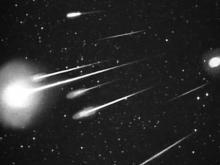MSQP Practice: Test Your Gear, Create Valuable Data
MSQP Practice: Test Your Gear, Create Valuable Data

HamSCI hopes to have many stations participate in the upcoming (12-13 December, 2025) Meteor Scatter QSO Party. As with any astronomic activity (especially one that peaks over just a 1 to 2 day period) it helps to be prepared. HamSCI suggests that future MSQP participants practice making QSOs and/or receiving pings from the meteoroids entering the Earth's atmosphere. Three upcoming showers/practice opportunities are listed the table below.
Aside from participants gaining confidence in their antenna, receiver and software, the data collected prior to the MSQP will have scientific value. HamSCI fully welcomes and encourages those making meter scatter (MS) QSOs, or those who choose to operate receive-only during these events, to submit their data, in the form of WAV files, to HamSCI's data repository at zenodo.org. Complete instructions are available at the MSQP GitHub Site.
Note: There is no need for a separate submission form, as there won't be any scoring of entries for dates other than the official MSQP period (12-13 December, 2025). Questions are welcome at the HamSCI mailbox.
Lastly, don't forget about the resources available to MS ops, rookie to expert:
- The Ping Jockey Central website is a real-time messaging tool, where friendly MS ops share tips regarding what they are working, when and where. Simply reading the live comments can point you in the right direction, on the right bands, whenever meteor showers are active.
- The weekly HamSCIence telecon offers an open net-type roundtable where questions are welcome (details are on the HamSCI Get Involved page) (the second Thursdays of each month are generally reserved for presentations, roundtables may not be possible on those days).
- HamSCI's 'How-to' MSQP page
Meteor Showers for Remainder of 2025
The following meteor showers from the American Meteor Society website may be useful for testing your equipment and data collection and upload procedures for the HamSCI Meteor Scatter QSO Party prior to the Geminids (also listed). The zenithal hourly rates (ZHRs) are small but may provide useful rates. Testing using sporadic meteors especially during the diurnal peak around sunrise each morning is also appropriate but the population index, r, for showers indicates a slightly higher probability of larger meteoroids which may be useful for testing.
|
Shower |
Activity Period |
Maximum Date Sol Lon |
Radiant RA Dec |
Velocity Km/s |
r |
Max. ZHR |
Time |
Moon % |
||
|
Orionids (ORI) |
Oct 02-Nov 12 |
Oct 23 |
209.5° |
06:25 |
+15.8° |
65.5 |
2.5 |
20 |
0500 |
02 |
|
Leonids (LEO) |
Oct 28-Dec 07 |
Nov 17 |
235.4° |
10:16 |
+21.8° |
69.7 |
2.5 |
15 |
0500 |
27 |
|
Geminids (GEM) |
Dec 01-Dec 21 |
Dec 13 |
261.85° |
07:33 |
+32.4° |
33.8 |
2.6 |
120 |
0100 |
24 |
Further Information (Thanks to Rob, NN4NT, for all of the information on this page)
The full list of large meteor showers (Class I) as well as the smaller Class II shower list are available at https://www.amsmeteors.org/meteor-showers/2020-meteor-shower-list/
A nice graphic of the Comet Halley material responsible for the Orionids and Eta Acquarids is available at https://www.amsmeteors.org/meteor-showers/meteor-shower-calendar/ You may want to click “View Other Showers and Learn More” to see animations for other showers.
You may check the current activity levels as measured by the Canadian Meteor Orbit Radar near London, Ontario at https://fireballs.ndc.nasa.gov/ Click on “Radar” on the menu at left.
